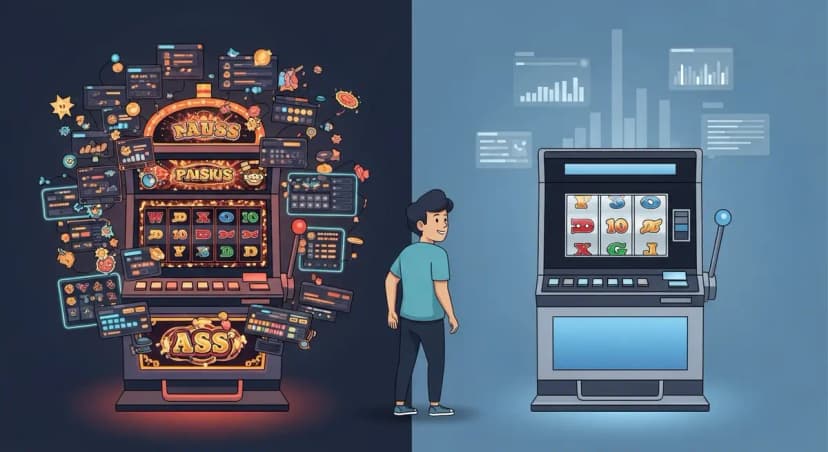2025 Q1 Report: The Most Popular Slots, Live-Dealer, and Table Games

Best Casinos 2025
As we move through 2025, the online casino landscape continues to evolve, with player preferences shaping platform offerings at a rapid pace. At CasinoRank, we've analyzed aggregated data across dozens of online casinos to identify the most played slot, live-dealer, and table games for Q1 2025. Our findings highlight clear patterns in user behavior, the growing dominance of certain providers, and trends worth watching as the year progresses. Let’s dive into the data and uncover what’s shaping the player experience right now.
Our Methodology
We analyzed game performance in Q1 2025, covering the period from January to March. Using iGaming Tracker, we gathered real player data on how games were featured and promoted across top online casino platforms. The dataset includes both desktop and mobile placements, with a focus on game visibility and content share.
Now, let’s break down how each game category performed during the first quarter.
Most Popular Slot Games of Q1
Slot games continue to dominate the online casino space in terms of volume and session duration. Players favored high-volatility titles and recognizable game mechanics. Here are the ten most-played online slot games in Q1:
| 🏆 Rank | 🎰 Slot Game | 🖥️ Provider | 🔥 Why It’s Hot | 📈 Player Appeal |
|---|---|---|---|---|
| 1 | Gates of Olympus | Pragmatic Play | Massive multipliers & global hype | High volatility thrills |
| 2 | Sweet Bonanza | Pragmatic Play | Candy visuals, simple bonus game | Easy-to-love mechanics |
| 3 | Big Bass Splash | Pragmatic Play | Fishing theme + free spins upgrade | Nostalgic, fun theme |
| 4 | Book of Dead | Play'n GO | Timeless classic with big wins | Legacy-style volatility |
| 5 | Big Bass Bonanza | Pragmatic Play | Iconic character & steady hits | Low-stakes fun |
| 6 | Starlight Princess | Pragmatic Play | Anime style + Olympus mechanics | Niche meets proven format |
| 7 | Sugar Rush | Pragmatic Play | Cluster wins & colorful chaos | Visual excitement |
| 8 | Legacy of Dead | Play'n GO | Darker twist on the classic formula | Book-style loyalty |
| 9 | The Dog House Megaways | Pragmatic Play | Megaways + adorable theme | Big win potential |
| 10 | Madame Destiny | Pragmatic Play | Fortune-telling vibe + multipliers | Mystery & volatility |
Trending Slot Themes & Mechanics
- Theme: Greek mythology, candy themes, and fishing-themed slots held significant appeal.
- Cluster Pays & Tumble Mechanics: Sugar Rush and Sweet Bonanza show sustained player interest in games that offer non-traditional reels and payout systems.
- Multipliers & Bonus Buys: Most top games offer some form of multiplier and bonus buy, reflecting player demand for fast-paced excitement.
Key Takeaways from Q1 2025’s Slot Market
Q1 confirmed the sustained dominance of Pragmatic Play. Nine out of the top ten most-played slots were developed by Pragmatic Play, with Gates of Olympus once again leading the pack. Play’n GO continues to thrive with enduring classics.
New slots struggled to break into the top 10, suggesting that players are gravitating toward trusted titles and mechanics.

Best Played Live Casino Games in Q1
The live-dealer segment continues to thrive, driven by immersive game show formats and classic table replications with enhanced visuals and pacing. The top 10 titles are:
| 🏆 Rank | 🃏 Live Game | 🖥️ Provider | 🔥 Why It’s Hot | 📈 Player Appeal |
|---|---|---|---|---|
| 1 | Crazy Time | Evolution | Game show-style chaos with bonus rounds | High-energy entertainment |
| 2 | Live Lightning Roulette | Evolution | Visual effects + electrifying multipliers | Thrill-seekers & roulette fans |
| 3 | Live Blackjack Azure | Pragmatic Play | Stylish tables with smooth UX | Premium blackjack experience |
| 4 | Live Blackjack | Evolution | Classic setup, flawless execution | Trusted and consistent play |
| 5 | XXXtreme Lightning Roulette | Evolution | Supercharged version of Lightning | Adrenaline with massive wins |
| 6 | Live Mega Fire Blaze Roulette | Playtech | Bonus wheel and multiplier blend | Hybrid of RNG & live action |
| 7 | Live Blackjack Classic | Evolution | Simple, fast-paced and accessible | For seasoned table players |
| 8 | Classic Speed Blackjack | Evolution | Rapid gameplay, no waiting | Time-efficient thrill |
| 9 | Live Roulette | Playtech | Traditional feel with modern flair | Straightforward roulette fans |
| 10 | Live Sweet Bonanza Candyland | Pragmatic Play | Branded mashup of slots & live games | Slot lovers crossing over |
Takeaways from Q1’s Live Dealer Market
- Evolution Gaming: Evolution Gaming remains the dominant player in live casino, particularly in roulette and entertainment-based titles.
- Game Shows Remain Popular: Crazy Time and Sweet Bonanza Candyland show players are drawn to entertainment-focused formats.
- Lightning Roulette Variants Dominate: High-payout potential and immersive production make these staples.
- Blackjack Consistency: Multiple variations continue to draw steady numbers, especially during peak hours.

Top Played Table Games in Q1
Despite the dominance of slots and live dealers, traditional RNG table games continue to appeal to specific segments, especially mobile users and budget-conscious players. The best titles of the quarter are:
| 🏆 Rank | ♠️ Table Game | 🖥️ Provider | 🔥 Why It’s Hot | 📈 Player Appeal |
|---|---|---|---|---|
| 1 | European Roulette | NetEnt | Smooth interface & player-friendly layout | Classic roulette fans |
| 2 | Premium Blackjack | Playtech | Polished graphics with side bets | Strategic card players |
| 3 | Blackjack MH | Play’n GO | Multi-hand action for deeper control | Advanced blackjack lovers |
| 4 | 20p Roulette | Inspired Gaming | Ultra low stakes for casual sessions | Budget-conscious players |
| 5 | Blackjack | Relax Gaming | Clean, modern design with fast rounds | Players who value efficiency |
| 6 | Roulette | Relax Gaming | No-fuss layout and solid mobile play | Fans of straightforward gameplay |
| 7 | Premium European Roulette | Playtech | Elegant visuals with pro-level features | Traditionalists & high-rollers |
| 8 | Game King Video Poker | IGT | Iconic poker terminal vibe in digital form | Nostalgic video poker fans |
| 9 | Roulette | Draft King | Intuitive and responsive online layout | Beginners trying roulette |
| 10 | Five Play Draw Poker | IGT | Multi-hand format with classic rules | Poker fans wanting variety |
Q1’s Online Casino Table Game Highlights
- Budget-Friendly Games: There’s a noticeable appetite for traditional experiences with reliable payout structures. Titles like 20p Roulette continue to gain traction with low-stakes players.
- Roulette and Blackjack: These 2 classic names continue to be the bedrock of table game engagement.
- Video Poker Stability: Video poker saw stable performance, with IGT's titles catering to a niche but loyal audience.

Provider Performance Snapshot
In Q1 2025, a clear picture emerged regarding which game providers are currently setting the pace in the online casino industry.
Pragmatic Play
Pragmatic Play led across the board, with an exceptional presence in both slot and live casino categories. Eight of the ten most-played slots were developed by Pragmatic, and their live game Blackjack Azure and Sweet Bonanza Candyland secured strong positions among the top-performing live-dealer titles. This consistent performance highlights Pragmatic Play's ability to deliver high-engagement content across multiple verticals.
Evolution Gaming
Evolution maintained its dominance in the live casino space, securing six of the top ten spots, including the highly popular Crazy Time, Lightning Roulette, and XXXtreme Lightning Roulette. Their continued innovation in live entertainment formats has kept them firmly ahead in this category, though competition is growing.
Play’n GO & Playtech
Play’n GO remained relevant through its evergreen slot titles like Book of Dead and Legacy of Dead, showing that classic mechanics and trusted game design still resonate strongly with players. Meanwhile, Playtech saw strong activity in both live and RNG formats, particularly with Premium Blackjack, European Roulette, and Mega Fire Blaze Roulette gaining traction.
Others
Lastly, Relax Gaming, IGT, and NetEnt showed reliable performance in traditional table games. While they didn't dominate the charts, they continue to serve niche and strategy-oriented players, especially in blackjack, roulette, and video poker.
Overall, the quarter showcased a competitive but clearly tiered landscape, with top providers consolidating their strengths while others carved out focused, high-performing niches.
Key Trends and Dynamics of Q1 2025
Q1 2025 brought several notable shifts in player behavior and content preferences across online casinos. One of the most defining trends was the continued cross-vertical success of branded game content—titles like Sweet Bonanza performed strongly in both slots and live game formats, suggesting that player loyalty is increasingly driven by brand familiarity and unified experiences. Additionally, high-volatility mechanics paired with fast-paced gameplay saw increased demand, particularly in mobile-first environments where shorter, more intense sessions are favored.
We also observed a growing appetite for visually enhanced live-dealer content, with roulette variants that offer dynamic multipliers and visual effects (such as Lightning Roulette and Mega Fire Blaze Roulette) outperforming traditional setups.
Meanwhile, classic table games like blackjack and European roulette maintained consistent engagement, particularly among more seasoned players seeking stability and straightforward odds.
As our senior iGaming content writer and analyst Emily Thompson explains:
“We’re seeing a clear maturation in player preferences. It’s no longer just about volatility or payout—it’s about the overall experience. Players are drawn to content that offers familiar themes, layered interactivity, and the flexibility to switch between slots, live tables, and RNG formats without breaking immersion. The providers that succeed in Q2 will be the ones that offer cohesive ecosystems, not just standalone titles.”
Another key factor shaping market behavior is the software dominance of a few leading providers. Pragmatic Play and Evolution, in particular, have maintained a commanding presence across both slots and live casino content. This concentration of player activity around a limited set of providers highlights the growing importance of technological stability, content diversity, and user experience. These providers have optimized their software not only for engaging gameplay, but also for fast loading times, seamless mobile performance, and real-time interactivity. In contrast, smaller or less-established studios may struggle to compete unless they offer a unique niche or superior user interface.
These dynamics suggest that while innovation remains crucial, player retention is increasingly built on content consistency and user experience across devices and formats. As we move forward, game studios and operators alike will need to balance novelty with familiarity to keep players engaged.
Conclusion
The first quarter of 2025 reinforces a familiar trend: players continue to gravitate toward games that combine reliability, up-to-date mechanics, and high entertainment value. For deeper insights, trends, and the latest reviews, continue exploring CasinoRank.



